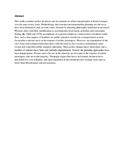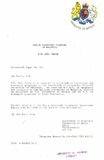| dc.description.abstract | This study examines policy decisions and investments in
urban transportation in Kuala Lumpur over the past twenty
years . Methodology and concepts in transportation planning
are shown to have been influenced, and, in some cases,
dictated by planning philosophy fashioned in advanced
Western cities with little modification to accommodate local
needs, priorities and constraints. During the 1960s and
1970s an emphasis on expensive highway construction to
facilitate traffic flow, and a clear neglect of facilities
for public transport resulted in a transportation system
favourable to private users at the expense of public
passengers. However, an examination of the city's long term
transportation plan shows that the trend is now toward a
nationalised, state-owned and controlled public transport
enterprise. Many policy changes have taken place and a
number of schemes have been only partially implemented.
Overall, the planning approaches have been inappropriate.
Private users who are in the minority are favoured at the
expense of public passengers who are in the majority. The
paper argues that heavy investment decisions have precluded
low-cost solutions, and rigid regulation in the enterprises
has wrongly been seen as better than liberalisation and
privatisation. | en_US |


